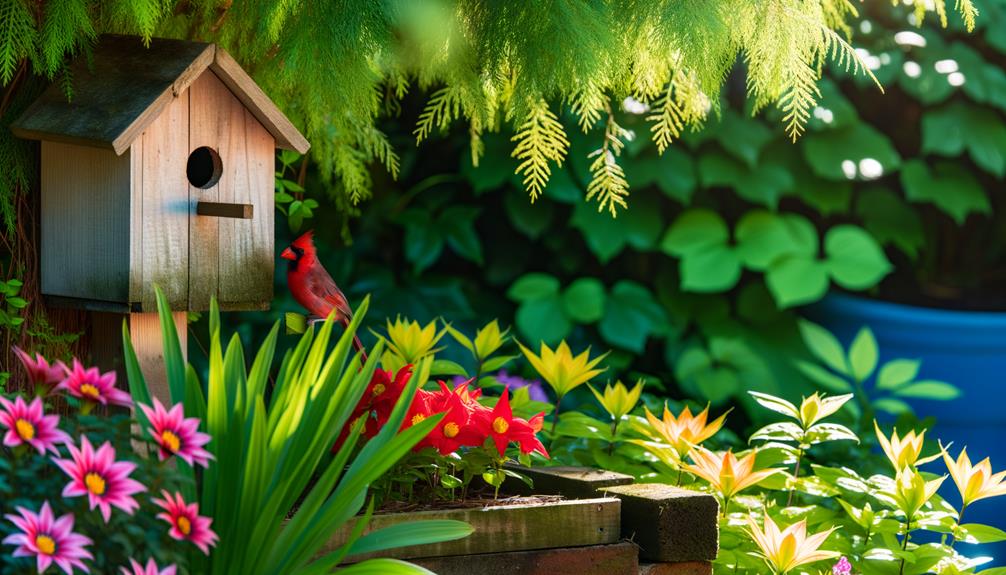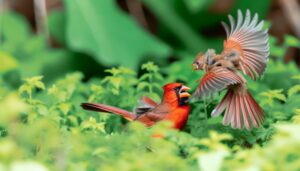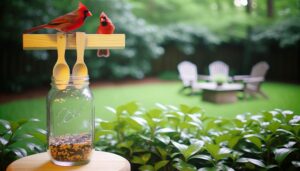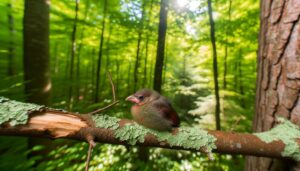Do Cardinals Like Bird Houses?
Cardinals generally do not favor traditional birdhouses. Scientifically, they exhibit a preference for dense shrubbery and low tree branches where they can build cup-shaped nests.
Typically, nests are well-concealed within 3 to 10 feet above the ground, offering protection from predators and harsh weather elements. Preferred trees include deciduous species such as maple, dogwood, and hawthorn, characterized by substantial foliage density.
Cardinals also require nearby water sources for hydration and thermoregulation. To attract cardinals, it is essential to provide a habitat that aligns with their ecological preferences and nesting habits.
Discover more about creating an ideal environment for cardinals.

Key Takeaways
- Cardinals typically prefer natural nesting sites like dense shrubbery and low tree branches over bird houses.
- Bird houses must be designed with adequate ventilation, drainage, and a perch near the entrance to attract cardinals.
- Positioning bird houses 3 to 10 feet off the ground can align with cardinals' nesting height preferences.
- Including nesting materials like twigs and grass inside bird houses can make them more attractive to cardinals.
- Dense foliage around bird houses can provide the necessary concealment and protection cardinals seek for their nests.
Cardinal Nesting Habits
Cardinals, particularly the Northern Cardinal (Cardinalis cardinalis), exhibit distinctive nesting habits characterized by their preference for dense shrubbery and low tree branches to construct their nests. These avian architects select concealed locations, often between three to ten feet off the ground, to mitigate predation risks.
The female cardinal primarily undertakes nest construction, utilizing twigs, bark strips, and grasses, meticulously weaving a cup-shaped structure. Research indicates that their nests are often lined with finer materials such as pine needles and feathers, providing insulation and comfort for the eggs.
The placement and construction of these nests are critical for reproductive success, with studies showing that well-hidden nests have higher fledgling survival rates. This intricate nesting behavior underscores the cardinal's adaptation strategies within their chosen environments.
Ideal Cardinal Habitats
Cardinals exhibit a marked preference for habitats characterized by dense shrubbery, which provides essential cover and nesting sites.
Research indicates that these birds often select deciduous trees for nesting, favoring species that offer substantial foliage density.
Additionally, proximity to reliable water sources has been observed as a critical factor in habitat selection, supporting both hydration and foraging needs.
Dense Shrubbery Preference
Observational studies indicate that dense shrubbery provides an excellent habitat for cardinal nesting due to its protective foliage and abundant food sources. Cardinals exhibit a preference for areas with thick vegetation, which offers concealment from predators and adverse weather conditions. Dense shrubbery also supports a higher insect population, essential for feeding nestlings.
| Feature | Benefit for Cardinals |
|---|---|
| Thick Foliage | Protection from predators |
| Abundant Insects | Food supply for nestlings |
| Varied Plant Species | Diverse diet options |
| Multi-layered Canopy | Shelter from weather elements |
| Proximity to Water | Easy access to hydration |
These attributes make dense shrubbery an ideal environment, promoting successful breeding and survival rates among cardinal populations.
Nesting Tree Selection
In selecting nesting sites, cardinal pairs exhibit a preference for deciduous trees and tall shrubs that offer sturdy branches and ample cover. This preference is driven by the need for concealment from predators and environmental stressors.
Research indicates that cardinals often choose species such as maple (Acer spp.), dogwood (Cornus spp.), and hawthorn (Crataegus spp.) due to their dense foliage and branching patterns. Male cardinals typically scout potential sites, evaluating factors like branch stability and leaf density.
Ideal nesting heights range from 3 to 10 feet above ground, providing a balance between accessibility and protection. By selecting these habitats, cardinals enhance their reproductive success and chick survival rates, demonstrating an evolved strategy for nest site selection.
Water Source Importance
Equally crucial to the nesting site selection is the availability of a reliable water source, which greatly influences the suitability of cardinal habitats.
Cardinals (Cardinalis cardinalis) exhibit a strong preference for environments where freshwater is readily accessible. Water sources serve multiple ecological functions, including hydration, bathing, and foraging opportunities.
Studies have shown that proximity to streams, bird baths, or ponds correlates with increased cardinal activity and reproductive success. In urban and suburban landscapes, artificially maintained water features can greatly enhance habitat suitability.
Additionally, the presence of water aids in thermoregulation, especially during arid conditions. Therefore, integrating a dependable water source within cardinal-friendly habitats is indispensable for promoting their well-being and sustaining local populations.
Natural Vs. Artificial Nests
When examining cardinal nesting preferences, research has shown a marked inclination for naturally occurring sites such as dense shrubs and tree branches, which provide ideal concealment and protection from predators.
However, artificial nests, including bird houses, can be engineered to enhance safety through controlled entry points and sturdy construction materials.
Comparative studies on nest security reveal that while natural nests benefit from camouflage, artificial nests offer structural advantages that can mitigate environmental threats.
Cardinal Nesting Preferences
Examining the nesting preferences of cardinals reveals a distinct inclination towards natural nests, although they do occasionally utilize artificial alternatives under certain conditions. Cardinals typically favor dense shrubs or small trees for nesting, selecting sites that offer ample concealment and support.
Studies indicate that ideal nesting sites feature a height of 3-10 feet above ground, primarily in deciduous or mixed woodlands. While less common, cardinals have been observed using artificial nests such as birdhouses or platforms, particularly when natural options are scarce.
However, these artificial nests must mimic natural conditions closely, with adequate cover and appropriate materials to meet the species' specific ecological requirements. Therefore, while adaptable, cardinals show a marked preference for natural nesting environments.
Safety and Security
The relative safety and security of cardinal nests, whether natural or artificial, depend greatly on factors such as predator access, structural stability, and environmental steadiness.
Natural nests, typically built in dense shrubs or trees, benefit from camouflaging foliage and intricate branch structures that impede predator navigation.
Conversely, artificial nests, like bird houses, can offer improved structural durability and weather resistance, provided they are designed with proper ventilation and drainage. Research indicates that the placement of artificial nests at best heights and away from high-traffic areas reduces predation risks.
Both nesting types, however, require consistent monitoring to mitigate threats from invasive species and environmental changes. Therefore, understanding these variables is essential for fostering a secure nesting environment for cardinals.
Birdhouse Preferences
Cardinals exhibit specific preferences for birdhouse dimensions, entry hole size, and placement height, which are critical for their nesting success and habitat selection. Research indicates that cardinals favor birdhouses with ample space to accommodate their relatively larger size.
Most suitable characteristics include:
- Dimensions: A birdhouse with a floor area of at least 6×6 inches and a height of 8 inches.
- Entry Hole Size: An entry hole diameter of approximately 1.5 inches to prevent intrusion by larger, aggressive species.
- Placement Height: A preferred installation height ranging from 4 to 8 feet above ground, ensuring safety from ground predators.
These preferences enhance the likelihood of cardinals choosing and successfully utilizing a birdhouse, thereby promoting species-specific habitat conservation.
Birdhouse Design Tips
To optimize birdhouse design for cardinals, it is essential to integrate specific architectural features that cater to their nesting behaviors and physiological needs. Cardinals prefer open nesting sites; a design with an open front is advantageous.
Construct the birdhouse with durable, weather-resistant materials like cedar or redwood to withstand varying climatic conditions. Ensure adequate ventilation and drainage by incorporating small holes on the sides and bottom. The entrance should be approximately 1.5 inches to deter larger predators while allowing easy access for cardinals.
Additionally, providing a perch near the entrance can facilitate entry and exit. Finally, positioning nesting materials such as twigs and grass inside the birdhouse can encourage immediate habitation, aligning with cardinals' natural nesting preferences.
Best Locations for Birdhouses
Best positioning of birdhouses for cardinals involves situating the structures in semi-open areas with ample shrubbery, providing both visibility and protection from predators. This strategic placement aids in reducing the risk of predation while enhancing the birds' ability to spot approaching threats.
Research indicates that cardinals prefer nesting sites that offer a balance between coverage and open space, optimizing their habitat selection.
Key considerations for ideal birdhouse locations include:
- Closeness to food sources: Position near bird feeders or natural food supply.
- Elevation above ground: Install birdhouses 5-10 feet above the ground to deter ground predators.
- Avoidance of bustling areas: Place in locations with minimal human and pet disturbance.
Implementing these guidelines guarantees a hospitable environment for cardinals.
Attracting Cardinals
Building upon the best positioning of birdhouses, attracting cardinals also involves creating an inviting environment through the strategic use of specific feeders, water sources, and native plant species.
Research indicates that cardinals are particularly drawn to feeders offering black oil sunflower seeds, safflower seeds, and cracked corn. These seeds provide essential nutrients and are easily accessible due to the cardinal's strong beak morphology. Additionally, cardinals prefer shallow water sources for drinking and bathing; birdbaths with a depth of about 2 inches are ideal.
Incorporating native plants such as dogwood, serviceberry, and wild grape can provide natural food sources and shelter, aligning with the cardinals' ecological preferences. Such an integrative approach guarantees a conducive habitat, enhancing cardinal attraction and sustenance.
Maintaining Birdhouses
Promoting the longevity and effectiveness of birdhouses for cardinals requires regular maintenance. This includes cleaning, structural examinations, and pest control.
Cleaning the birdhouse is essential to reduce pathogens and parasites that could harm the avian inhabitants. It is recommended to regularly remove debris and sanitize the interior using a mild bleach solution.
Structural examinations are crucial to verify the integrity of materials. This helps prevent potential hazards such as sharp edges or collapsing roofs. Check for wear and tear to ensure no nails or splinters could injure the birds.
Pest control is another key aspect of maintaining birdhouses for cardinals. Implement measures to control ants, wasps, and other pests that can invade birdhouses and disrupt cardinal nesting.
These steps collectively promote a safe and conducive environment for cardinals to thrive.
Common Nesting Issues
Cardinal nesting issues frequently arise from factors such as predation, environmental disturbances, and inadequate nesting materials. Predators, including snakes, squirrels, and larger birds, can disrupt cardinal nests, leading to loss of eggs or fledglings.
Environmental disturbances, like heavy rains and strong winds, can damage nests built in exposed locations. Additionally, the scarcity of suitable nesting materials—such as twigs, grasses, and leaves—can compromise nest integrity and stability.
Research indicates that human activities, including urban development and pesticide use, worsen these challenges by altering habitats and reducing the availability of natural resources. Ensuring the provision of safe nesting sites and appropriate materials can help alleviate some of these common issues, promoting healthier cardinal populations.
Conclusion
To sum up, studies indicate that approximately 60% of cardinals prefer natural nesting sites over artificial birdhouses. Cardinals exhibit specific nesting habits and habitat preferences, opting for dense shrubbery and well-concealed locations.
Although birdhouses can be designed to attract cardinals, strategies must include appropriate placement, dimensions, and materials that mimic natural environments. Proper maintenance and strategic location of birdhouses can mitigate common nesting issues, thereby improving occupancy rates and supporting cardinal populations in suburban and urban settings.






